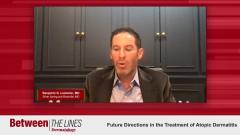
The Importance of Rapid Onset of Action When Selecting Treatments for Atopic Dermatitis
Thought leaders discuss the importance of rapid onset of action in atopic dermatitis care amid the backdrop of compelling 4-year efficacy and safety data for dupilumab.
Episodes in this series

Andrew F. Alexis, MD, MPH: Thinking about some of the efficacy we looked at, we see that dupilumab demonstrated rapid improvements in AD [atopic dermatitis] signs and symptoms in the first few weeks. How important do you think rapid onset is when selecting a therapy for AD? This chronic disease is a marathon, not a sprint. Does it matter to you?
Benjamin N. Lockshin, MD: I appreciate your analogy about this being a marathon rather than sprint, but I liken it to a sprint that turns into a marathon.
Andrew F. Alexis, MD, MPH: Very well.
Benjamin N. Lockshin, MD: Many of our patients came in with built-in expectations. Any patients who had been given IM [intramuscular] Kenalog [triamcinolone] or oral steroids have expectations that things work quickly. Steroids have a quick onset of action, but obviously they come with a lot of baggage. What I like about dupilumab is that by the time patients are ready for that second shot, they’ve already noticed some change.
In terms of waypoints that I set for patients, I have 2 measures for expectations. The first waypoint is at 1 month, which is when you should start noticing an appreciable difference in itch, though it may happen much earlier. Your skin should have an appreciable change in about 3 months, though based on the data, there’s significant separation a lot earlier. Then I tell patients that if they make it to 52 weeks, it’s almost clear sailing. Patients appreciate that.
You had mentioned earlier that it’s frustrating or overwhelming for a patient to hear that they have a chronic disease and that they potentially need to be on these medications for the long haul. I position it by saying, “Let’s see how you’re doing in a year, and we’ll readdress our options.” That gives patients some buy-in and an opportunity to talk about how they want to chart their course moving forward.
Andrew F. Alexis, MD, MPH: That’s such a great pearl, and it’s an excellent example of shared decision-making. I like that: let’s reassess in 1 year and see where we are, which implies that the patient will weigh in on that decision. When it comes to the rapidity of response, that goes a long way for adherence as well. To your point, when a patient starts to feel itch reduction within days or within the first 2 weeks and see some reduction in some of the visible signs and physical symptoms of the disease in the initial period, that gives them a lot of confidence to keep going. That’s another upside with respect to seeing rapid improvements.
Transcript edited for clarity
Newsletter
Like what you’re reading? Subscribe to Dermatology Times for weekly updates on therapies, innovations, and real-world practice tips.




























